|
PDF-200 penetrometer by SoilControl
for measuring firmness in fruit and to test the grade of maturity,
with measurement range of up to 20kg, RS-232 port and optional software
|
|
The PDF-200 penetrometer is highly useful in testing the maturity of many types of fruit. This digital penetrometer offers a higher accuracy and resolution than any other analogue device. With the PDF- 200 penetrometer you will obtain valuable information, no only about the optimum time for picking fruit, but about the progress of the fruit from when it is picked until it is consumed, including when it is being stored and shipped.
The PDF-200 penetrometer is controlled by a microprocessor, is easy to read an accurate and can be fixed to an optional test position. It is powered by batteries or by a mains adaptor (300mA power source available seperately). The display of the penetrometer can be turned 180° to allow for better visibility when taking measurements.
To transfer data from the penetrometer to a computer, you need the optional software pack with data cable. Data transfers to a computer, using the software, at a rate of one reading every 2 seconds. The test position is ideal for measuring in quality control and in laboratory experiments. This link shows an overview of penetrometers more suitable to your needs.
|
|
|
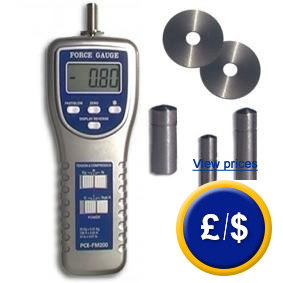
|
| The importance of measuring the firmness of fruit for testing maturity. |
|
To talk about the maturity of fruit, its important to distinguish between physical maturity and commercial maturity. Physiological maturity can only transpire while the fruit is still on the plant and is the last moment when the fruit can be picked to be sold. Commercial maturity occurs later, and indicates the best time to consume the fruit, when its colour, flavour and texture are ideal for the consumer. In the case of the climatic fruit, the commercial maturity of the fruit can occur some time after it has been picked.
While fruit is maturing, important changes occur inside, such as changes in colour, form and texture. It's important to have objective values available with those that evaluate the changes in the fruit as it matures, to allow for decisions to be made as to when the fruit should be picked and processed (to determine the quality of fruit from the moment it becomes a product to its final consumption). The firmness of the fruit, measured by the penetrometer, one of the most objective parameters in relation to the fruits maturity and as such is one of the most common techniques used in testing. Other methods are to determine the colour or the content of soluables using a refractometer (this technique is proportional to measuring total sugar and thus the sweetness of the fruit). If you are looking for refractometers to measure the sugar content of fruit, you can see them at this link.
Generally, the firmness or hardness of fruit measured by a penetrometer decreases as the maturity process occurs. Of course, you have to take into account that the firmness of the same fruit can vary, in general terms such as fruit variety or the region where it is cultivated, or due to its size or the temperature of the fruit when it is being measured by the penetrometer (the higher the temperature, the less firm the fruit is).
|
| Important information you should know about the PDF-200 penetrometer |
|
The PDF-200 penetrometer provides the force exerted upon the fruit in grams (1g = 0.001kg), with which the pressure exerted in kg/cm² can be obtained, taking into account the size of sensor being used. For example, for the same value obtained by a penetrometer of 4320g, for each sensor used, the real exterted pressure will be the value in kg divided by the diameter of the sensor that took the measurement:
|
nominal diameter
of sensor (mm)
|
Effective area of
the sensor (cm²)
|
Exerted pressure
(Kg/cm²)
|
| 6(optional) |
0.28 |
15.43 |
| 8(standard) |
0.5 |
8.64 |
| 11.3(standard) |
1 |
4.32 |
Here are link to provide access to function tables for recommended ranges for different types of fruit:
* Range of 0 - 1kg. (Appropriate for fruits such as grapes or cherries), with the 6mm diameter sensor
(Range 0 - 1kg. 6mm).
* Range of 0 - 5kg. (Appropriate for plums, lemons and other medium hard fruits) using the 6mm
diameter sensor (Range 0 - 5kg. 6mm) or the 8mm diameter sensor. (Range 0 - 5kg. 8mm).
* Range of 0 - 13kg. (Appropriate for fruits such as apples, pears, peaches or kiwis) using the 8mm
diameter sensor (Range 0 - 13kg. 8mm) or the 11.3mm diameter sensor. (Range 0 - 13kg. 11.3mm).
* Range of 0 - 20kg. (Appropriate for very hard fruits) using the 11.3mm diameter sensor
(Range 0 - 20kg. 11.3mm).
This link has more detailed information about the tables and graphs showing the equivalence between the force measured by the penetrometer and the pressure applied to the sensor (in ranges according to DIN).
This digital penetrometer offers the best accuracy and resolution available compared to analogue penetrometers. On important advantage, aside from having three different penetrating sensors, it eliminates the need to purchase multiple analogue devices required to perform the same functions as this PCE-PTR 200 digital penetrometer.
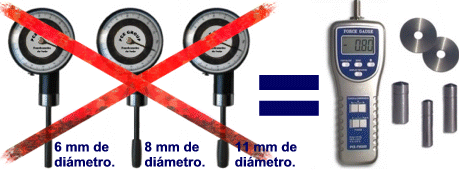
|
| Technical specifications |
| Model |
PDF-200 |
| Maximum measurement load |
20 kg / 196 N |
| Resolution |
10 g / 0.05 N |
| Accuracy |
±0.5%, +2 digit |
| Units of measurement |
grams / Newton |
| Maximum overload |
30 kg |
| Interface |
RS-232 |
| Software and cable |
optional |
| Data transmission
|
Data transfers to a computer, using the software, at a rate of one reading every 2 seconds.
The penetrometer can trasfer data at a quicker rate when transferring from memory to a computer, one reading every 0.25 seconds using Windows hyper terminal.
|
| Display |
5 digit LCD; 10mm high |
| Measurement functions |
measures firmness of fruit with Peak Hold function |
| Power |
6 AA batteries or mains adaptor |
| Dimensions |
227 x 83 x 39mm |
| Weight |
550g |
| Examples of use for the PDF-200 penetrometer |
|
The PDF-200 penetrometer measuring the firmness of a plum in the fields
|
How to measure the firmness of a piece of fruit using the PDF-200 penetrometer:
-
Choose to most appropriate sensor for the type of fruit that is going to be measured.
-
Remove the skin of the fruit.
-
Position the sensor perpendicular.
-
Press the sensor until it penetrates up to the indicating mark on the sensor.
-
View the value measured as shown on the display of the penetrometer.
|
|
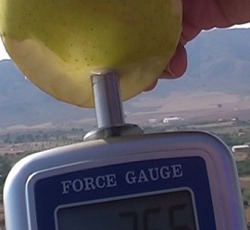
Penetrometer measuring the firmness of an apple with an 11mm sensor
|
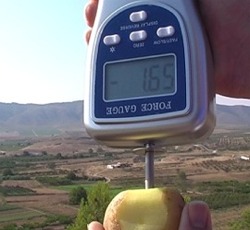
Penetrometer measuring the firmness of a potato with an 8mm sensor
|
| Software |
|
Readings can be transferred to a computer by way of the RS-232 connection and software. The following link has information pertaining to the software pack.
|
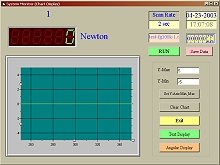
Software indicating the time interval in which the device shows and adjusts measurement values. Can indicate digitally and with graphic curves.
|
|
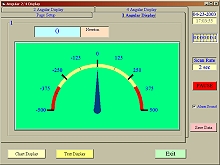
Software with the value curves for the penetrometer: Can choose between representation in analogue or digital.
|
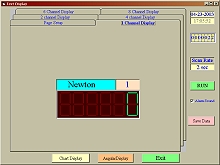
Image of software with digital representation which provides a higher accuracy of data reading.
|
Contents
PDF-200 penetrometer
User's manual
Sensor with 6mm diameter(optional)
Sensor with 8mm diameter
Sensor with 11mm diameter
Two spacing washers
Carrying case
|
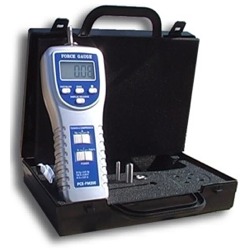
PDF-200 penetrometer with its sensor |
Optional accessories
- Software and cable to trasnfer data to a computer
- Mains adaptor (230V / 50Hz)
- Sensor with 6mm and baterry dispenser.
|
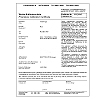
|
|
|
|
|
|
